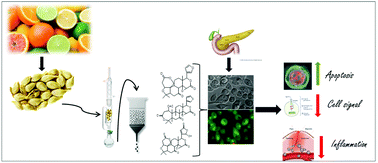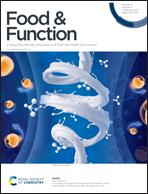Citrus limonoids induce apoptosis and inhibit the proliferation of pancreatic cancer cells†
Abstract
In our recent study, we demonstrated that certain limonoids isolated from citrus seeds induced apoptosis in human pancreatic (Panc-28) cells. In this study, limonin, nomilin and limonexic acid (LNA) were investigated for understanding the possible mode of cytotoxicity in cultured pancreatic cancer (Panc-28) cells. All three limonoids inhibited Panc-28 cell proliferation, with IC50 values less than 50 μM after 72 h of incubation. The induction of apoptosis was confirmed through the cleavage of caspase-3, decreased mitochondrial membrane potential, and expression of apoptosis-related proteins. The Bax/Bcl2 expression ratio was increased up to 11-fold in cells pre-treated with 60 μM limonoids for 48 h. Apart from this, the limonoids also induced the expression of p21, and exhibited anti-inflammatory activity through decreasing the expression of cox-2, NF-κB and IL-6. Based on these results, we were interested in understanding the possible mode of inhibition by LNA, which exhibited the highest activity. The treatment of Panc-28 cells resulted in dose- and time-dependent induction of apoptosis-inducible proteins. In addition, treatment with 60 μM LNA resulted in the activation of Akt-associated signals to induce apoptosis, and the same was confirmed by the effects of the compounds on pAkt, p53, VEGF and caspase proteins. The results of this study demonstrated the cytotoxicity of limonoids to human pancreatic cancer cells through the modulation of genes involved in proliferation and survival.



 Please wait while we load your content...
Please wait while we load your content...